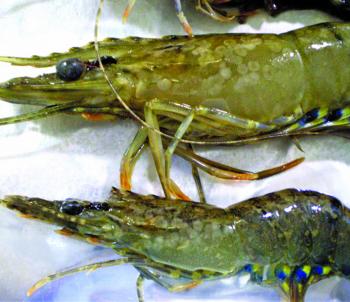This month will be the start of the banana prawn season for 2017. Since just before Christmas we have had a continuing stream of advice notices from DAF (Department of Agriculture and Fisheries) regarding white spot syndrome virus. They have ranged from downright scary to boring. Some of them have come from Fisheries QLD and some from Biosecurity Queensland.
The problem with this is that due to Christmas and New Years, we needed some clear and concise advice and some strong and effective action from Biosecurity Queensland to further enforce a message to the general fishing public that this could be very serious. This time of year we have more recreational fishers on the water than any other time and a lot of them are not part of the usual networks that that information flows through.
WSSV or white spot syndrome virus can be devastating to our recreational fisheries as well as the commercial and aquaculture prawn industries. It is extremely virulent and has a very high mortality rate. It can wipe out prawns and yabbies, infect mud crabs and sand crabs and is transferred by worms. This virus survives freezing and can only be killed by being cooked at very high temperatures or when all their hosts are dead.
Australia has been lucky that until now it has been declared white spot free. That doesn’t mean that we haven’t had instances previously. So far they have been able to be controlled before running rampant through wild stocks. We have been leading a charmed existence until now, because even though white spot is rampant overseas, our international borders are certainly not closed to this disease.
WSSV causes no disease in humans, so uncooked prawns that have white spot have been allowed to be imported into Australia and still are. With no suitable information in the public arena and generally no advices on the product, imported raw prawns are sold through retail outlets for human consumption.
Anyone who purchases these prawns might toss the shells in the local creek to feed the crabs or use the last few as bait. They run the risk of causing a white spot outbreak. This disease is so virulent and with such a high mortality that if either of those scenarios were to occur during peak prawn season, the results could be devastating – from just one instance.
Two things need to happen urgently – Firstly the message needs to get far and wide that prawns not sold specifically as bait should not be used as bait and no prawn shells should be disposed of in our waterways. Secondly, no imported raw prawns should be allowed into this country. This is an excerpt from an advice we recently sent to Biosecurity Queensland with respect to the two new programs for WSSV.
Recreational fishers consider the threat of WSSV both real and implied to be significant. The impact of white spot to the everyday activities of recreational fishers has the ability to go from inconvenience to absolutely catastrophic in a very brief span of time. Because this virus has an impact on worms that are carriers through to prawns, yabbies and crabs that will suffer significant mortality and includes many fish that may be caught having only just ingested the infected prawns or yabbies, there is not a fisher that would not feel the effects of this virulent disease on their fishing.
This surveillance program must be paired with sufficient legislative power to achieve the goals of the program and prevent any further transmission or re-infection.
More than a half of Queensland’s recreational fishers (approximately 350,000) live in South East Queensland with ready access to fish in Moreton Bay. There are no words to indicate the magnitude of the effect that this virus has the potential to inflict.
It should be noted that given the time frames and the time of year to consider these programs, Sunfish has not had the capacity to canvas responses from all the recreational fishers likely to have views on the white spot situation. Based on the responses and comments that we have received, we believe that the prevention and control program is deficient given the possible magnitude of the threat.
The risk management approach for the importation of raw prawns to prevent introduction of white spot into Queensland and Australia has failed. The risk assessment approach should be reviewed as a matter of urgency and we advocate a complete ban on the importation of raw prawns as the best alternative to prevent further transfers of white spot into Australia.
A high level information program should be immediately implemented by DAF to warn people that imported raw prawns must only be used for human consumption, and not be used as bait, fed to aquatic animals, or discarded into local waterways.
We are aware that the prawn aquaculture industry is also seeking a ban on the import of raw prawns, as this is the most likely way that white spot can be introduced into Queensland and Australia. We support this position. Sunfish Queensland urges Biosecurity Queensland to take a firm proactive position against white spot syndrome virus and prevent it from becoming our next tilapia, because the consequences could be much more catastrophic.
Please share your opposition to the importation of raw prawns into Australia that could wipe out recreational fishing as we know it.
Reads: 2732
The prawns with white spot syndrome virus have white spots on the inside of their shells. This is an excised cuticular epithelium with calcified white spot lesions on cuticle.

These prawns have classic WSSV white spot lesions visible.

This virus quickly causes devastation to prawns, crabs and other estuary species.




